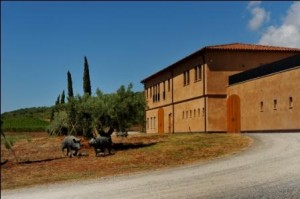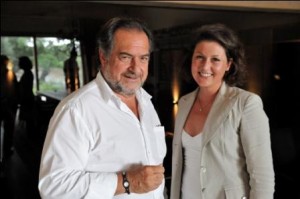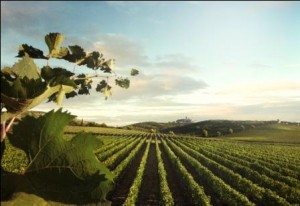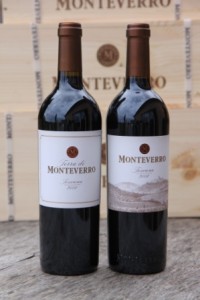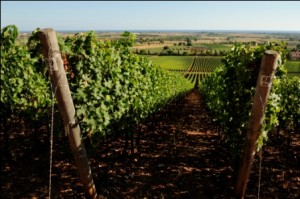The next Super Tuscan?
June 7, 2011
Michel Rolland is advising a brand new property in Tuscany which aims to reach the level of quality and fame as Sassicaia, and it was an honor for me to be able to sample the four inaugural wines Domaine Monteverro has produced.
All photos on this page copyright Monteverro Toscana.
Many thanks to sales and marketing director Olympia Romba for sending me the samples of their very first vintage, 2008.
Until recently, wheat was the only crop being grown in the fields outside Capalbio, a Tuscan hill town popular with Italians for being so well preserved. But the soils here are perfect for vine growing, something that German owner Georg Weber not only noticed, but had verified with detailed chemical analyses and microclimatic data before buying the 50-hectare land in 2003. By 2008, the grapes began to bear the kind of fruit Weber was seeking and only this year were the wines released.
The vineyards, just five kilometers away from the sea, range in altitude from 30 to 70 meters, with ideal south/southwest exposure. Cabernet Sauvignon is the prevalent variety, followed by Cabernet Franc, Merlot, Syrah, Grenache and Petit Verdot. Just a bit more than a hectare of Chardonnay is also grown. In addition to winemaking assistance from Michel Rolland, the estate benefits from the advice of one of the world’s foremost pruning experts, Michel Duclos. It also benefits from the advice of Lydia and Claude Bourguignon, the world’s leading experts in soil microbiology.
Everything is indeed in place to make a world class wine.
After tasting the inaugural vintage, I am certain the at least three of the four will get very high marks from Robert Parker’s Wine Advocates. I am not sure if Mr. Parker will grade them himself, as they are Italian wines, but the blends are unusual in that no Italian varieties are to be seen. Instead, we have the two Rhone varieties to make one red – the Tinata. Only 6,000 bottles produced, with an estimated retail price of €79, this wine is made from 70% Syrah and 30% Grenache, aged 20 months in French oak (50% new oak), with no fining or filtration. It clocks in at 15.5% alcohol.
The Bordeaux varietals make up the estate’s premier wine, the Monteverro, which consists of 60% Cabernet Sauvignon, 25% Cabernet Franc, 10% Merlot and 5% Petit Verdot. Its estimated retail is €109, with 12,000 bottles produced. The wine is aged 24 months in French oak, 70% new, and clocks in at about 15% alcohol.
For €29 per bottle, the estate produces 24,000 bottles of its “second wine” called Terra di Monteverro, with 40% Cabernet Sauvignon, 35% Cabernet Franc, 15% Merlot and 10% Petit Verdot. Aged in 60% new oak for 20 months.
Finally, it produces just 3,000 bottles of pure Chardonnay, aged 18 months in French oak, 30% new. It retails for €75.
My critique
The wines are very well made, and even though they are a bit too large scaled for my personal taste, they will please many a palate. The wines were tasted on 30 May in Beaune at the Caves Madeleine restaurant. Many thanks to owner and sommelier Laurent Prelin for allowing us to open the bottles without any corkage fee, as he was also curious to try them.
Not unexpectedly, the best of the bunch is the Monteverro Toscana 2008. With a fruit- filled and big palate, it is rich and intense. Its 15% alcohol is not really showing as such, and that is a positive. Fellow taster Jürgen Steinke, who tastes regularly with the Grand Jury Europeen, believes that it could be confused with certain Right Bank Bordeaux wines from 2009 or 2010, if tasted blind – even though the blend is majority Cabernet Sauvignon.
The second wine, Terra de Monteverro 2008, made from slightly higher yields, has a fresher nose, although the palate does show a “Rollandesque” plum-like richness. Jürgen said that it “flirts” with over-ripeness, and that “no doubt a lot of people will like this” and I would agree. The alcohol, again 15%, is also well integrated, but it again resembles a rich St Emilion from the 09 or 10 vintages. It certainly will make many people happy.
I was perhaps alone in appreciating the Tinata 2008, which mixes the Syrah and Grenache. This has the most alcohol, at 15.5%, but it is a Rhone blend, after all. Its succulence would make any Rhone Ranger happy. Still, I could see why a Burgundy fan like Mike Grammer, who tasted with us in Beaune, and a person sensitive to jammy fruit, like Jürgen, would like this less. In any case, I was able to turn off my Burgundy love switch, and focus on the Rhone jam, and I appreciated this wine for what it is.
But I think we all came to a similar conclusion for the Chardonnay 2008. Already it looked too dark for its age. It displayed sweet butterscotch aromas and flavors and was very New World Chardonnay-like, with the oak derivation too present. Perhaps the estate should consider no new oak and even somewhat higher yields than the 20 hectoliters per hectare, to lend more freshness? I am not sure…
A word on pricing
I am not sure that the prices proposed are that intelligent. Perhaps the idea is that “if it not expensive, it is not going to sell”? Yes, Michel Rolland is the consultant and the estate has invested in the input of Michel Duclos and Lydia and Claude Bourguignon. Great care is being taken to make the best possible wines from young vines, too. But the prices are pretty darn high, we all agreed, wondering how well the wines will sell and whether it would have been a better idea to have more modest price tags… at least for the first vintage.
In any case, best of luck to the team at Monteverro, a property which looks like a dream location and worth a visit.

